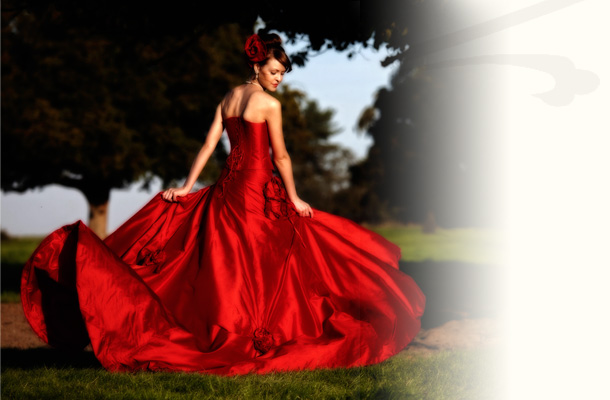Red Silk Dress Biography
Source(google.com.pk)
Red: Luck
Prior to Queen Victoria's wedding, royal brides were typically adorned in heavy red gowns embellished with silver thread. Additionally, throughout much of Asia and the Middle East, red is associated with passion while white is the color of mourning.
In China, Vietnam and Taiwan, red is believed to attract joy and luck. Although most modern brides opt to wear a variety of colorful dresses during the event, a red dress typically makes an appearance, particularly during the formal tea ceremony. Taiwanese brides also don elaborate phoenix crowns covered with a red headscarf.
In India, it is believed that wearing white invites unhappiness and widowhood, so brides dress in red silk saris to indicate their purity. Since modern Indian brides are not constricted by color choices, maroons, yellows, pinks, purples and oranges regularly stroll down the aisle.
As a symbol of the passing of their old lives, Japanese brides first appear wearing a white kimono, which is removed to reveal a red kimono, a gesture that signifies rebirth and commitment to the new family. Brides may also wear a white kimono lined in red to express their optimism for the new journey they are embarking upon.
Red is a complex color. Oh boy, is it complex, and it has been through quite the proverbial tumbler in its time. Red has been tossed around with sinners and saints, warriors and prostitutes, kings and merchants. It has been on top and it has been on bottom: From associations with the sun to accusations that creating the color required consorting with the devil himself. Red is a color with a multitude of meanings.
It is not surprising, then, that chubby cupids get thrown into the mix with lusty lingerie when red shows up in time for Valentine’s Day. In honor of this most fiery of holidays, we wanted to take a moment to sort through the back stories. So whether we are swiping Revlon Red across our lips or are lucky enough to step out in a signature red Valentino, we get an inkling of the many messages we are sending.
The histories and meanings of red run deep, starting with basic human communication. In Hebrew Adam translates to red and the ancient Aztec word tlapalli means both red and, simply, color. “You could say quite literally that red is the first color most languages recognize,” says author and color expert Jude Stewart. “Red’s most vital connotations across cultures is, unsurprisingly, blood, and with that passion in all its forms.” According to Greek mythology, the red rose originated from the blood of the slain Adonis, Aphrodite’s lover. Red became both the universal symbol of lovers, as well as nature’s cycle of life and death.
Above all else, red has historically been the color of money, especially when it comes to clothing. In fact, until the invention of synthetic dyes, red was the equivalent of couture: Only the wealthy wore it because its production required imported dyestuffs, driving up costs and a lust for it along with it. Until the 19th century, wearing red signified a person of means, whether or not the color was even in vogue. Early religious leaders propped up red as the choice color of the Catholic Church, and yet etiquette experts of the 18th century decried red as “vulgar and unsuitable,” advising any woman of good taste to refrain from wearing it.
Tied to economy as it was, red logically fell out of favor at the same time as Europe’s wealthy ruling class did. “Associated as it was with aristocratic excess, red was not well suited to an age marked by the rise of bourgeois values,” writes Amy Butler Greenfield in her 2005 book, A Perfect Red. Many women continued to wear red anyway, until 1850 when Nathaniel Hawthorne’s The Scarlet Letter forever cemented the association between red and adultery—thanks to the condemning scarlet letter “A” forced upon Hester Prynne as a sign of her sin. Red was, again, sartorially out of step.
Red’s revival came about with innovations in synthetic dyes during the mid-19th century, and with it red gained a new clientele: the working class, who had a lot of fun appropriating the long out-of-reach color. Despite often staining the skin, or worse, poisoning the wearer, folks couldn’t help but don the vibrant hue that was formerly the exclusive property of the rich. In gaining a fan following among the commoners, though, red lost its upper-crust groupies. “[Red’s] very ubiquity,” Greenfield notes, ”made it déclassé.”







No comments:
Post a Comment